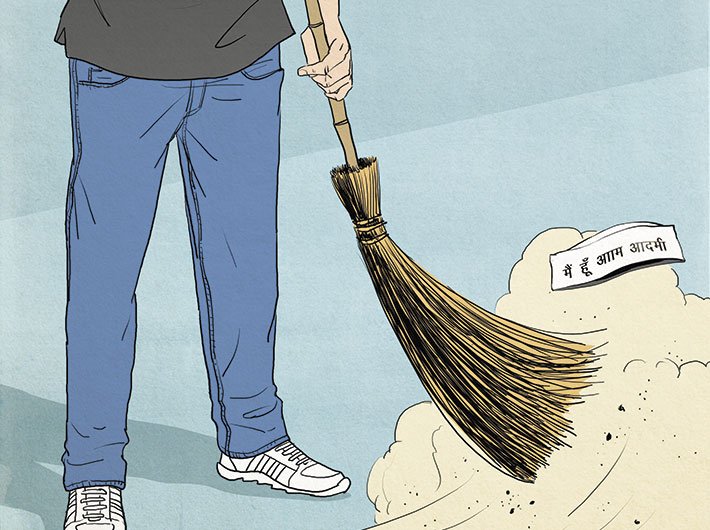How AAP has lost the narrative with the middle class, on whose support it won a massive victory in 2015
Chandramouli Vashisht, 29, an engineer who lives in Madhu Vihar, in the middle-class Patparganj locality of east Delhi, says that during the last Lok Sabha election, he voted for the BJP, but the very next year, during the state assembly election he cast his vote for the Aam Aadmi Party (AAP). This year, as the nation goes to the polls, he is not sure if he wants to vote for AAP, which has fielded candidates in all seven parliamentary seats of Delhi.
“The AAP government may have taken many good decisions, but nothing reaches us. They reduced the rates of electricity and water, but that was in 2015. What after that?” he asks. “The conditions of government schools and hospitals is said to have improved, but I wonder how many of my friends and relatives visit government hospitals or send children to government schools. What matters to us are better infrastructure, safety and security, etc. All I see the party doing is tweet against the central government. Does the Delhi CM really have no power? Though Atishi Marlena is contesting for AAP from my constituency, and she’s well educated and logical in her talk, I don’t think I’ll vote for her.”
In 2015, just a few months after Narendra Modi became prime minister with a clear majority, the fledgling AAP swept the polls to the Delhi assembly, winning a stonking 67 of the 70 seats. Arvind Kejriwal, a former civil servant who looks every inch the common man in his untucked shirt and pants, with a cap emblazoned with the the words ‘Mujhe chahiye swaraj’, became the chief minister. It was clear all sections of society – but especially the middle and the lower classes – had voted for AAP. After the Modi wave, this came as surprising, and even as a shock to the Bharatiya Janata Party (BJP).
So where does AAP stand today, as it contests all seven parliamentary seats in Delhi state in the 2019 elections? More pertinently, is the middle class still with the party when it comes to a parliamentary election? These are important questions, because the BJP – then and now – has been strongly backed by the middle class. It was the sudden shift of this class towards AAP for the assembly polls that brought it such a huge victory. To sense our way towards answers, it might help to analyse what brought AAP to power and how much it has made good on its promise.
“Kejriwal was seen as a harbinger of hope. From 2013 to 2015, he knocked at the doors of people and listened patiently,” says Gautam Chikermane, co-author of The Disrupter: Arvind Kejriwal and the Audacious Rise of the Aam Aadmi. “He didn’t promise a miracle but a change from the current scenario, a change from the politics of the nation. That AAP is not like the BJP or the Congress. He sold hope.”
And Pralay Kanungo, a professor of political science at Jawaharlal Nehru University who has written a paper on the AAP phenomenon, says, “AAP came with big media hype. Their talk of transparency and elimination of corruption brought them the support of different sections of society during the 2015 election. The Congress vote bank shifted to AAP, people unanimously voted for AAP, leading to a massive victory.”
Since the party did not play any caste card, nor raised any divisive slogans, it was a vote for change. And since Delhi was never a base of any regional party – the electoral battle was always a matter of prestige for the BJP and the Congress – the massive mandate that AAP got was a vote against corruption, a vote against traditional politics. It was a vote for a big change.
Perhaps it was the pressure of the huge mandate that forced Kejriwal to reduce electricity and water charges to half, according to Chikermane. “Within 24 hours of coming to power, he halved electricity charges and declared that every household would get 700 litres of water per day free. It was one of the most populist decisions,” he says.
Maybe that was the first sign of a changing of track, with AAP aiming straight for what would bring votes. Says Mohit Pandey, a political analyst who worked with AAP and also with CVoter, a polling agency, during the Delhi assembly elections, “AAP got 51 percent of the middle class vote, compared to 31 percent that went to the BJP. But less has been done for them. Most of Kejriwal’s schemes are for the lower classes.” In fact, Kejriwal declared where his sympathies lie when he told a national daily, “I know every section of society has voted for AAP, but it’s the poor who will never leave us.”
From there, it was a series of shocks for the middle class, with its expectations of a decorous IRS officer-turned-politician who would be different from other politicians. The structure of Delhi’s governance as a state – with policing and other important functions resting with the centre – did not help, as Kejriwal went into a head-on confrontation with the Narendra Modi government. Leaving deputy chief minister Manish Sisodia practically in charge of all administrative matters, Kejriwal took up cudgels with the lieutenant governor and Modi. Both sides traded charges, but, with his scrappiness, the Delhi chief minister came off looking bad.
Says Pandey, “We are conducting a survey, for which I met a lot of people in Delhi. Kejriwal’s confrontation politics may have raised his popularity among those belonging to the lower classes, but the middle and the upper middle classes are irritated with him. People do remember that former chief minister Sheila Dikshit of the Congress did not have any problems working with BJP prime minister Atal Bihari Vajpayee. It now seems the state government never tried to work with the BJP government at the centre. People feel Kejriwal is only trying to take on Modi, which they don’t like at all.”
Kejriwal’s intemperate statements, on all and sundry, too, did him in. Facing defamation cases, in February 2018, Kejriwal and Sisodia ended up writing apology letters to no less than 30 leaders across party lines – Bikram Singh Majithia, Nitin Gadkari, Kapil Sibal, Arun Jaitley and many others. At the same time, many valuable members of AAP started leaving the party, saying there was no democracy within. Rebels like Alka Lamba have said Kejriwal, for all the 30-plus extended sessions of vipassana he has done, has anger issues and calls legislators “luchcha” and “gadha” during meetings. Many volunteers who enthusiastically participated in AAP campaigns now say they are fed up and want to focus on their careers.
In 2015, soon after winning power, Kejriwal expelled three respected leaders, Prashant Bhushan, Yogendra Yadav and Anand Kumar (who then formed the Swaraj Abhiyan).
Sanjay Kumar, director at the Centre for the Study of Developing Societies (CSDS), says, “During the last four-five years, the AAP votebank has shrunk in the middle class. My studies say that this time the middle class will vote for the BJP in much bigger numbers than it did for the 2014 Lok Sabha elections. The reason is not just the disappointment of voters with AAP, but a pull factor is working in favour of the BJP – a euphoria about a strong nation and nationalism has been created, making people believe it is important to have a strong leader and that currently only Narendra Modi is that face. Yes, AAP promised a lot but its performance has been a disappointment to the middle class.”
After coming to power in Delhi, to a great extent, AAP has succeeded in alienating itself from the middle class. “The kind of image AAP has projected is that they are anarchist, confrontationist, and not stable,” says Kanungo. “People wonder if the party has time left for governance.”
He says AAP never expected to win 67 out of 70 seats, but when that happened, turning arrogant was easy for Kejriwal. “Now, AAP is only about Kejriwal. He knows there is no one to challenge him in the party, and that his diktat will be followed,” he says. “Instead of democratising the party, bringin in new leaders, he centralised power. Now, AAP is as leader-centric as the BJP and the Congress.”
In fact, there are many who say that, far from being the party with a difference it promised to be, it is no different from any other party. People point out its negative campaigns against the BJP and Modi, the huge spending on advertisement, its leaders’ appeals to the Hindu sentiment by visiting cow shelters and temples, its hot-and-cold dalliance with the Congress, its attempt to woo the 10 lakh bania voters through its selection of MPs for the Rajya Sabha.
“Today, there’s no difference between AAP and any other political party,” says Chikermane. “The middle class placed hope in AAP, but it has ended. Arvind Kejriwal has fallen, I don’t know why or how. Is it political compulsion that has made him indulge in vote bank politics? Or was he like this from day one? Though AAP has tremendous salience in the lower middle class and in the JJ colonies, the middle class is disenchanted.”
Chikermane, who interacts daily with local people in Delhi, says, “AAP needs to draft a new narrative in the Lok Sabha election. In 2013, when Kejriwal said all political parties are corrupt, people agreed. But now, people don’t agree that the Narendra Modi government is a ‘chor’. They feel Kejriwal’s political signature is to fight with anybody and everybody. In 2019, the middle class has ended up asking: why should we vote for AAP?”
It’s a damning question. But Atishi, the AAP candidate from East Delhi, defends her party. “People voted for Modi despite his communal image because they wanted a change, they wanted achche din, but good days did not arrive. People had huge expectation from the BJP government, like generating employment opportunities, controlling inflation, ushering in a corruption-free regime. But decisions like demonetisation and GST created havoc. In 2019, people know the reality of the Modi government, and they will not vote for him.”
She says she campaigns among the middle class residents during morning walks. “Initially, I was very hesitant in approaching them. But they welcome me, listen to me and agree the centre has not let the AAP government in Delhi function. It gives me confidence that I will win the election.”
As far as the opinions of political analysts are concerned, she says, “I don’t know why the experts feel so, but tell me which party has focussed on issues like electricity, water, school and education the way we do? Yes, the middle class does not send children to government schools, but in our regime, no private school has raised fees in the past four years. We have launched a programme for doorstep delivery of services. Yes, we do feel that we issue like cleanliness, safety and security bother citizens of Delhi. That’s why we are asking for Delhi people to vote us in the Lok Sabha 2019 polls if they support our full statehood demand, for the Modi government is not allowing our elected government to function properly."
She may take hope from the likes of Sanchayita Deb, a mother of two and a resident of Mayur Vihar Phase III. Says Deb, “Modi as PM, Kejriwal as CM. Both are honest and hard-working, though other party leaders and officials are lazy. I’ll vote for Atishi.”
deexa@governancenow.com
(This article appears min the April 30, 2019 edition)

